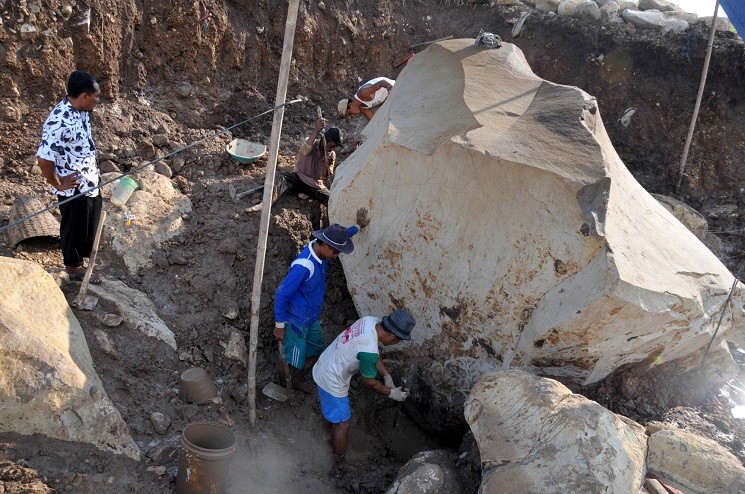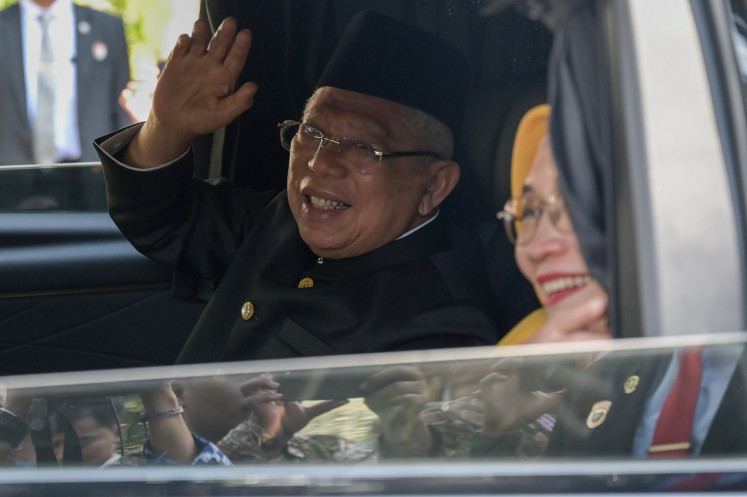Popular Reads
Top Results
Can't find what you're looking for?
View all search resultsPopular Reads
Top Results
Can't find what you're looking for?
View all search resultsNew ancient inscription adds insight into Mataram kingdom history
Change text size
Gift Premium Articles
to Anyone
A
n ancient inscription on an andesite slab presumed to be from the time of the Mataram kingdom in the 10th century was found during a recent excavation of an unnamed temple in Mojokerto regency, East Java.
East Java Cultural Heritage Preservation Agency (BPCB) excavation team leader Muhammad Ichwan told The Jakarta Post on Sunday that the inscription was dated 852 Saka (Javanese-Hindu lunar calendar), or 930 CE.
Ichwan said that would place the inscription at a time when the Mataram kingdom was ruled by the Mpu Sindok, famed for moving its seat from the area known today as Central Java to East Java.
The kingdom was a Javanese Hindu–Buddhist kingdom that flourished between the 8th and 10th centuries. It shared a name with the Mataram sultanate, another large kingdom on Java that lasted from the late 16th century to the 18th century.
Found in the excavation site in Gemekan village in Sooko district, the stone inscription was split in six, with one large fragment being the upper part of the inscription and five other smaller fragments.
The large fragment measures 90 centimeters long, 88 cm wide and 21cm thick. It contains at least 30 lines of legible ancient Javanese script.
The inscription is currently being stored at the East Java BPCB for research by epigraphers to make out the message.
Ichwan and his team found the stone inscription on Feb. 9 while excavating the northeast corner of the recently discovered temple.
“The northeast corner was damaged and under it we found an inscription. Regarding the temple, we have not found the name yet," Ichwan said, adding that he was still waiting for the findings from epigraphers to know the purpose of the temple.
Before being excavated, the temple was buried under at least 20 cm of soil on a mound of earth located in the middle of a farm in Gamekan village.
As of Sunday, the team had found that the temple on one side had a brick fence at least 30 meters long and 59 cm thick.
Ichwan said since the 1980s local residents had been aware of the existence of the broken temple after finding some remains.
In 2018, the East Java BPCB investigated the existence of the temple but the excavation was only carried out in 2022 in collaboration with the Kaloka Malang Community Empowerment Institute.
The finding adds further archeological data to reconstruct the history of the Mataram kingdom under the reign of Mpu Sindok, with at least 20 inscriptions from the era found.
Gemekan village, in which the temple and inscription were found, is currently about 20 km from the new capital city of the Mataram kingdom, according to the Turyyan inscription dated 851 Saka (929 AD), in which the king announced that the palace would be transfered to Tamwlang, or currently known as Tembelang village in Jombang regency, East Java.
The seat of the Mataram kingdom was moved under the reign of Mpu Sindok, a crown prince who succeeded the throne in around 929 CE and ruled until 949 CE.
An archeologist at the National Archeological Research Center, Titi Surti Nastiti, said the transfer of the royal capital city was based on East Java geographical conditions, including the presence of the Brantas River, which were more favorable to the kingdom's economic prospects.
Other experts have theorized that an eruption of Mount Merapi and a power struggle were the reasons behind the transfer.
"Some experts say the palace was located in Tembelang, Jombang, but I think it was in Malang, because the Turyyan inscription was found in Malang," Titi told the Post on Monday, adding that the transfer to East Java was not by conquest, since the region was part of the kingdom.
The Mataram kingdom royal capital was later transferred again from Tamwlang to Watugaluh, now identified as Watugaluh village, Jombang regency, East Java, according to the Anjukladang inscription dated 859 Saka (937 CE) and the Paradah inscription dated 865 Saka (943 CE).











